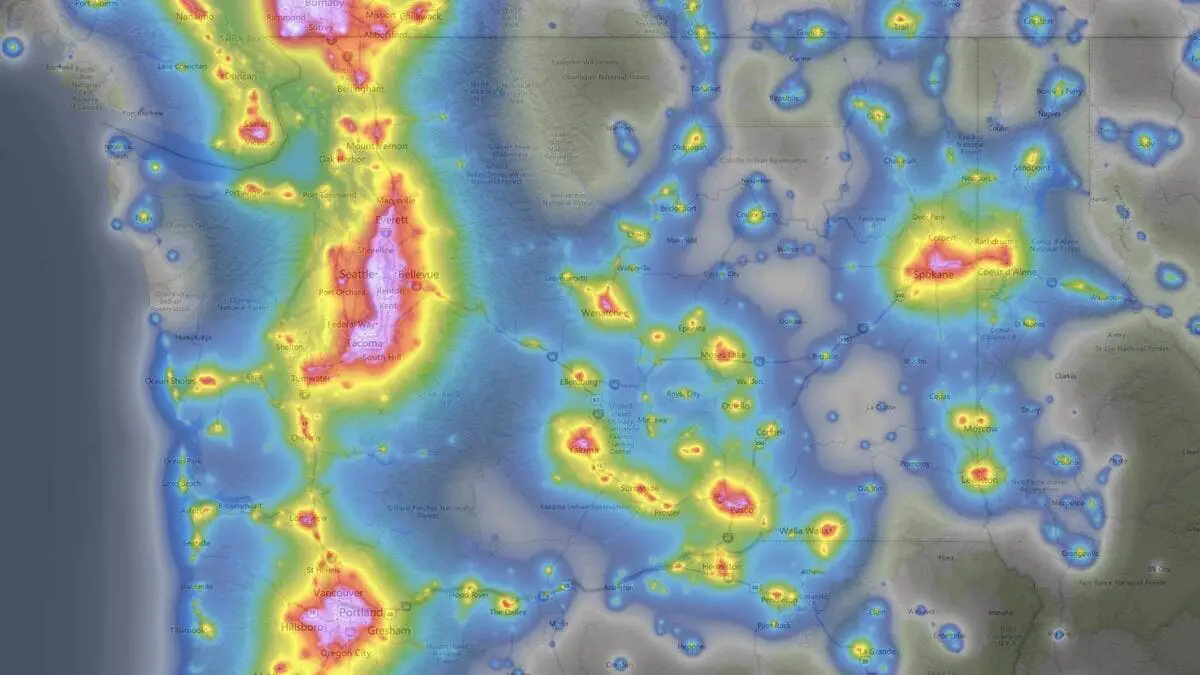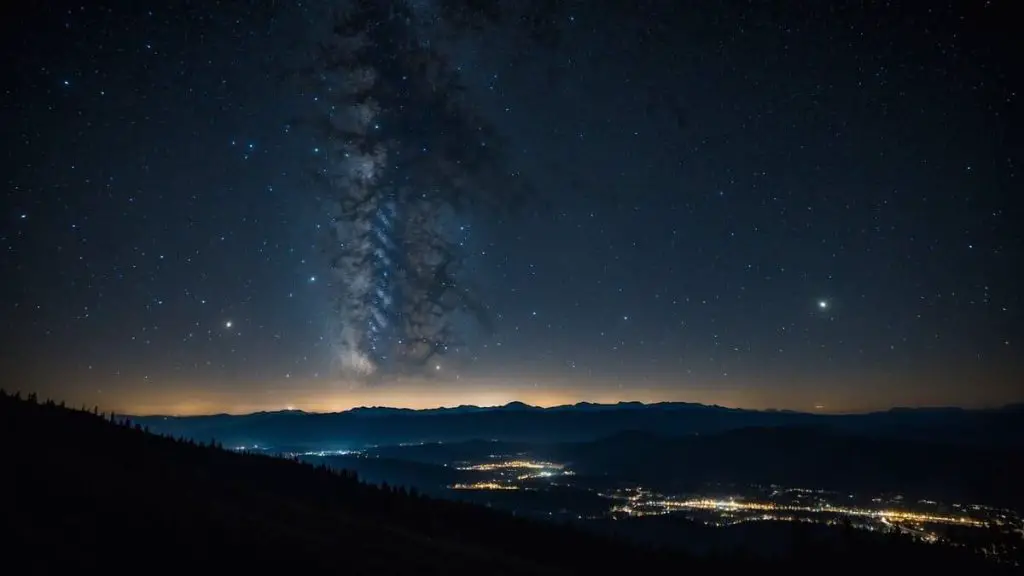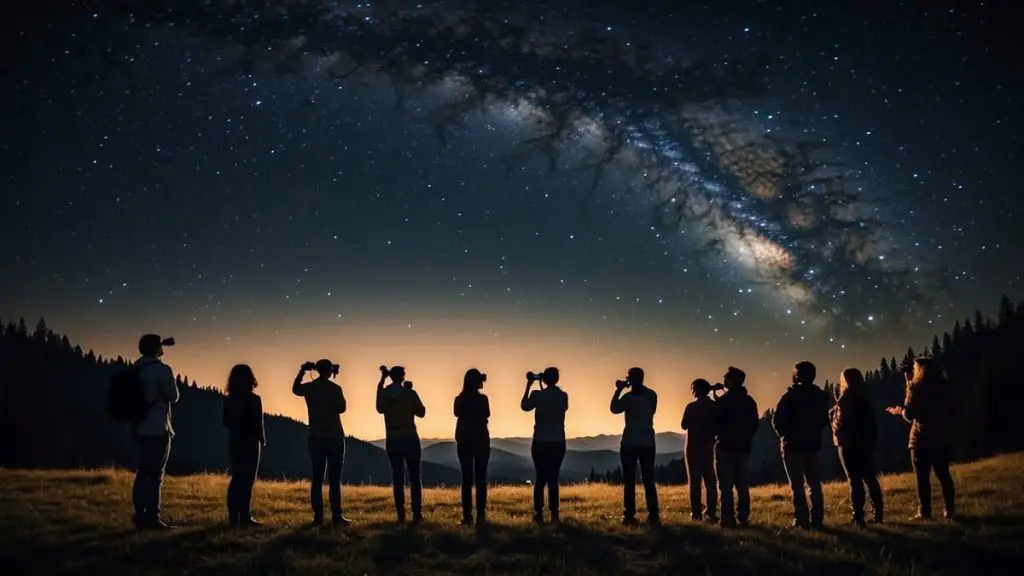You’re in Washington State, looking up at the sky, hoping to see a canvas of stars. But instead, you’re greeted by a glow of city lights. Finding places where the night sky truly shines is crucial for a stargazing enthusiast like you.
Yet, light pollution, the brightness caused by artificial lights, often steals away the view of the night’s natural wonders. This makes it challenging to experience the breathtaking starry skies you long for.
In this article, I’ll guide you through finding Washington’s best night skies. You’ll learn to locate the darkest spots ideal for stargazing using the Bortle scale and Dark Sky Maps. Let’s embark on a journey to uncover these hidden celestial treasures.
Key Things to Know:
- Use the Bortle scale and Dark Sky Map Washington State to find dark skies for the best stargazing.
- Explore top locations like Mount Rainier and North Cascades National Parks for minimal light pollution and clear star visibility.
- Join astronomy clubs and attend star parties for enhanced stargazing experiences.
Recommended For You
My Journey to Understanding the Dark Sky Map Washington State

When you look up at the night sky in Washington State, you want to see stars, not the glow of city lights.
If you love stargazing, finding spots with dark skies is essential. From my stargazing experiences, finding places with genuinely dark skies makes all the difference.
Light pollution often hides the night’s natural wonders from our view.
Light pollution is when artificial lights brighten the sky. I’ve witnessed how light pollution transforms a starry night into a dull glow. It makes it harder to see stars.
To help you find the best night skies, here’s what you need to know:
- The Bortle scale measures how bright the sky is because of lights. It goes from 1 to 9, where 1 is the darkest sky.
- Dark Sky Maps show you where the skies are darkest. Places with low light pollution are great for seeing more stars.
Here are steps to enjoy a dark sky:
- Look at a dark sky map for Washington.
- Find places that are away from city lights.
- Check the weather to make sure the sky will be clear.
- Bring a blanket and lay back to enjoy the stars.
Remember, the darker the place on the map, the more stars you’ll see. So grab your map and adventure in Washington’s beautiful night sky.
Top Locations for Stargazing

Washington State offers some of the best places to enjoy the stars in the US. Read on and discover where to find spectacular night skies.
FREE STARGAZING CHECKLIST
My 5-page Stargazing Checklist will enhance your astronomical observations.
Follow this free checklist to navigate the night sky with confidence, clarity, and a sense of preparedness for a rewarding stargazing experience.

Mount Rainier National Park
I found Mount Rainier National Park to be a must-visit stargazing destination.
The skies are dark and vast above, making it perfect for viewing stars. The park has many spots away from city lights to set up your telescope and gaze at the heavens.
Best Spots
- Sunrise area
- Paradise meadows
North Cascades National Park
When I visited North Cascades National Park, I discovered it’s a gem for night sky enthusiasts. You’ll find crystal-clear visibility with minimal light pollution.
Highlights
- The park offers incredible mountain backdrops.
- Look out for meteor showers on a clear night.
Goldendale Observatory State Park
The large public telescope offered a spectacular view of the cosmos during my visit to Goldendale Observatory State Park. You can join guided stargazing sessions here and learn more about the night sky.
Why Visit
- Educational programs are available.
- The observatory gives you a closer look at the stars.
Mount Baker – Artist Point
My experience at Artist Point provided a fantastic view of Mount Baker. The high altitude means fewer obstacles between you and the stars.
- Take a night hike to see the stars up close.
- Enjoy panoramic views of the heavens from Artist Point.
Methow Valley
Having spent nights in Methow Valley, I can attest to its prime stargazing conditions, dark skies, and stunning scenery. During the day, you can explore the trails and look up to see a star-filled sky at night.
What to Do
- Find a quiet spot in the valley.
- Watch the Milky Way with the naked eye.
Stargazing Events and Programs

Washington State’s stargazing events and programs have lots to offer if you love looking up at the night sky and marveling at the stars. You’re in for memorable experiences under the dark skies, from organized star parties to astronomy club gatherings.
Star Parties
Star parties are special gatherings where you can join fellow stargazers to observe the heavens. In Washington State, these events often happen at places known for their dark skies and natural beauty.
Here’s what you should know:
- Check Schedules: These events are usually scheduled to coincide with meteor showers or other celestial events.
- Family Friendly: Many star parties are perfect for families and beginners.
One great place for stargazing is Lake Wenatchee State Park.
Watch the Washington Trails Association for alerts on upcoming celestial events like meteor showers.
Astronomy Clubs
Your local astronomy clubs are great resources for learning and stargazing.
These clubs sometimes have:
- Regular meetings
- Public talks
- Telescope viewing nights
The Northwest Chapter of the International Dark-Sky Association provides access to resources. It can help you connect with local clubs. Being a part of a club can enhance your knowledge and give you more stargazing opportunities.
Astrophotography Essentials

When you want to capture the beauty of the night sky, certain essentials will ensure your astrophotography efforts shine.
Here’s what you need to know to get started with photographing starry skies and the Milky Way.
Best Practices
- Plan your shoot: Check the weather and moon phases; a new moon night is best for dark skies.
- Find a dark location: Use a Dark Sky Map to find the least light-polluted spots for clearer shots of the stars.
- Focus manually: Autofocus often struggles in low light. Use a bright star to set your focus to infinity.
- Long exposures: Start with a 20-second exposure and adjust as needed to capture more starlight without trails.
- Use the rule of 500: To prevent star trails, divide 500 by your lens’ focal length. This gives you the maximum exposure time in seconds.
Recommended Gear
- A sturdy tripod: Essential for keeping your camera still during long exposures.
- A DSLR or mirrorless camera: Choose one that performs well at high ISOs to reduce noise in your photos.
- Lenses:
- A wide-angle lens lets you capture more of the sky.
- A fast lens (f/2.8 or wider) captures more light, suitable for dark skies and meteor showers.
- A remote shutter release lets you take photos without touching the camera, keeping your images sharp.
- Extra batteries: Long exposures and cold nights drain battery life quickly.
Remember, it’s about experimenting with different settings and locations. Now, grab your gear and enjoy capturing the wonders of the night sky!
Dark Sky Preservation Efforts

Preserving the night sky in Washington State is about reducing light pollution. This helps you see the stars better and protects wildlife from too much light at night.
Now, let’s look at some groups working hard on this.
Methow Dark Sky Coalition
The Methow Dark Sky Coalition is a team of folks who love the night sky. They work together to:
- Teach people how light at night can be a problem for stars and animals.
- Make changes in local rules to reduce light pollution in the Methow Valley.
International Dark-Sky Association
The International Dark-Sky Association (IDA) is a big group working worldwide, including Washington State, to protect the skies. They:
- Help places earn the title of Dark Sky Parks, so your stargazing is top-notch.
- Offer guidelines on how to use outdoor lights to reduce light pollution.
Logistics and Considerations
When planning to observe the night skies in Washington State, knowing logistics like where you can camp and how accessible the sites are is vital.
Camping and Accommodations
- State Parks: You’ll find several state parks in Washington where you can camp under the stars. These parks often have designated camping spots where you can set up your tent among the trees and have a chance to spot wildlife. Make sure to book your spot early, especially during peak stargazing seasons.
- Near Canada: If you’re close to the Canadian border, remember that crossing into Canada for stargazing requires a passport and adherence to Canada’s entry requirements.
Parking and Accessibility
- Parking: Most state parks and dark sky spots have parking areas. Be sure to arrive early for the best spots, as they can fill quickly on clear, dark nights.
- Accessibility: Some parks boast wheelchair-accessible paths to stargazing areas so everyone can enjoy the beauty of the night sky. Here’s what you need to keep in mind:
- Check accessibility info before you go.
- Plan how you’ll navigate the terrain.
Frequently Asked Questions

What is the best time of year to stargaze in Washington State?
The best time to stargaze in Washington State is summer and early fall. These seasons offer clearer skies and longer nights, enhancing your stargazing experience.
Can I stargaze effectively in Washington State without a telescope?
Yes, you can effectively stargaze in Washington State without a telescope. Many locations offer stunning night sky views to the naked eye, especially during meteor showers and other celestial events.
Are there any stargazing apps that can enhance my experience in Washington State?
Several stargazing apps can enhance your experience in Washington State. These apps help identify stars, planets, and constellations, making your night sky exploration more informative and enjoyable.
TL;DR
- Use the Bortle scale and Dark Sky Maps to find the best stargazing spots with minimal light pollution in Washington State.
- Top locations like Mount Rainier, North Cascades National Parks, and Methow Valley offer exceptional star-viewing opportunities.
- Participate in star parties and astronomy clubs to enrich stargazing experiences and community engagement.
- For astrophotography enthusiasts, essential tips include planning your shoot, finding dark locations, and using appropriate gear for the best night sky captures.
- Efforts by groups like the Methow Dark Sky Coalition and the International Dark-Sky Association are crucial in preserving dark skies in Washington State.
I’m always eager to hear your thoughts and questions about stargazing and dark skies in Washington State. Whether you’re a seasoned astronomer or starting out, your insights and inquiries enrich our shared passion for the night sky.
Feel free to leave a comment or ask a question below – I’m here to share my experiences and learn from yours!




